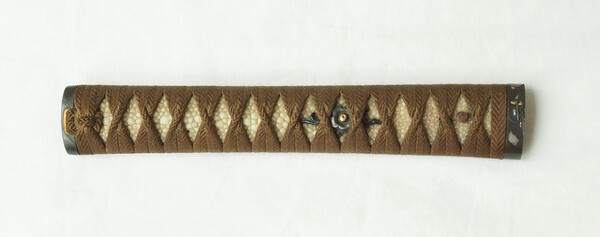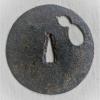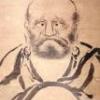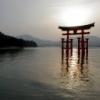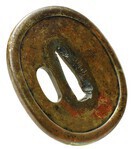Leaderboard
Popular Content
Showing content with the highest reputation on 07/17/2024 in all areas
-
8 points
-
Gentleman, I just got my copy of Owari To Mikawa No Tanko. Plate #240 is actually my tsuba. The groove in the nakago-ana really clinches the identification. Incredible luck to have blindly purchased a $175 tsuba 25 years ago in Singapore, only to come full circle to its provenance. Thanks so much, one and all for urging me not to take a blow torch to "fix" this tsuba .7 points
-
The handle is wrapped wrong. Too many red flags here. I think there is a reason the pig is in a poke; I'd stay away unless it is dirt cheap or you can see it in hand. Grey5 points
-
Thank you Jean If some of you can remember I wanted to do an utsushi of the “Oda Sa tsuba” but after some questions I decided that i can’t do it back then. I have learned a few things and now I will give it a try. So what I have is a blurry picture without much additional information and this texture is unlikely accurate but hopefully will help me to achieve my patination goals. After my Tsuba has some variations in the calligraphy I won’t say it is written by Naomasa. I have a little file work to do but then the patination experiments begin. This one is not so much influenced by my own experiments and maybe more tasteful.4 points
-
Hi Jake, welcome to the forum. Unfortunately this a bad Chinese fake, which have been ubiquitous on ebay for decades now. http://www.jssus.org/nkp/fake_japanese_swords.html4 points
-
To-ken Society of GB monthly newsletter "Programme 81" gives an account of the talk given by Basil Robinson. He reminisces the time as a British army captain he sorted through 1800 surrendered swords in 1945. Mountbatten had access to all of these. "Programme No.37" has a letter from Han Bing Siong describing the sword at Windsor Castle and speculates on the sword Mountbatten returned to Japan. Unfortunately, I cannot lay my hands on these newsletters at the moment, perhaps someone has copies of them? Back in early postwar Britain Mountbatten wrote a memo listing those who were to be presented with swords but noted that they haven't arrived in the UK yet . I'm still searching for this. On the internet somewhere is a film clip of Mountbatten at his home, holding one of the swords surrendered to him, he talks at length on this. I'll look for it when I get time.. A gunto sword with a blade by Yasutsugu is on display at the Commando Training Centre and is presented annually. It is yet another one said to have belonged to Field Marshal Count Terauchi Hisaichi. It's known as the Mountbatten Sword. Quite a few pictures of this sword being presented at that establishment can be googled.3 points
-
Gentleman, I just got my copy of Owari To Mikawa No Tanko. Plate #240 is actually my tsuba. The groove in the nakago-ana really clinches the identification. Unbelievable. I think it actually speaks well of the commentator that the discussion is on the composition and integration of the large motifs into the hisu-ana and as a connective element of the rim. Rather than the meaning of the motifs, there is discussion of the features of the forging process. Thanks again for your contributions to this thread. I've learned so much.3 points
-
Hi, A recent purchase from a local auction house. A Heianjo piece unfortunatley almost all of the hira zogan has gone except for some very minute pieces and the karigane on the spokes of what I believe is a 24 spoke wheel, but it would have been very nice when first made. The zogan extends over the mimi but most of this has worn away. The hitsu ana looks to be plugged with lead. Shows the level of work that has gone into produce the inlay. The Buddist symbolism of the piece I think relates to Ashoka? H: 82mm W: 79.5mm Mimi: 5.4mm Seppa dai: 4.50mm (Nakabiku) Nakago-ana: 28mm x 8mm There is a similar piece in the Jameel Centre - http://jameelcentre..../7/10237/10344/20053 but is a chrysanthemum. Noted as 17th century. PS - it's not as bright as it looks in the images.3 points
-
3 points
-
I have had this small Kanayama tsuba for some time, purchased in Singapore before I started collecting tsuba, and subsequently lost during move back to Boston. It has been rediscovered, although I honestly don't know how I acquired it and from whom is was purchased (probably on eBay or an antique shop). I did have an interest in nihonto and Japanese antiques in general at that time. Anyways, it took me a while to notice that there is a well-defined gouge or cut out in an elongated and sharp vertical groove present on the left middle edge of the nakago-ana. I thought it was damage. However, in Eckhard Kremers study "A Kyoto Master and His Workshop," he describes this kind of feature as common to Ko-Sukashi from the same workshop if not the master (see photo below from his study). These gaps were often filled with strips of copper indistinguishable from the sekigane that we often see including those present on my tsuba. Has anyone else encountered this kind of cut out? Who can fill it in with a copper strip? I'm pretty handy with metalwork applied to restoration of vintage electric guitars, but I am not keen on tackling this kind of work.2 points
-
Hi Colin, Ill wait for the more experienced to answer your translation questions. What I am able to answer, is that these are Hozon papers, not TokuHo The easiest way for me to tell the difference is the top left punched out area. I got this image from this link: http://www.nihontocr...se_sword_papers.html All the best, -Sam2 points
-
The parenthesis portion says "Den Shimada" attributing this Sukemitsu to the Shimada school. The certificate is a Hozon certificate. These contain some small security features noted in another NMB thread:https://www.militaria.co.za/nmb/topic/49197-new-nbthk-origami-security-feature-question/2 points
-
2 points
-
Guessing that they were done as a quick and shoddy way to tighten up the fit and stop things rattling around, with regards wrong thickness seppa. Though just a guess.2 points
-
2 points
-
After spending the better part of the last year learning and studying, (and getting a ton of help, advice and insight from members here) I finally figured out what I wanted and acquired my first blade. I had it narrowed down to two schools, with Naoe Shizu being the winner. For my budget, this one stood out in particular for its Soe-hi (I think that's the term) and jigane. It is certainly not flawless, but the polish is decent and what really drew me to it was the period, and sheer physicality of it. TH Naoe Shizu Nagasa 70.3 cm Motohaba 3.1 cm Kasane 6.5-5.6 cm Shinogi .87 cm Weight 785g Despite the typical 70.3 cm and slightly wide 3.1cm motohaba, it feels absolutely massive in hand; like I could split a vehicle in half. That might be a poor thing to judge a blade on, but it sure feels good. I don't have a macro lens so had to do the best I could with a wide angle. Some day I will pick up a Sigma 105 and do this justice. PS: that's not a hagire in the boshi; just struggled with even lighting and didn't notice until I took my setup down Hopefully it is a worthy first acquisition!2 points
-
2 points
-
2 points
-
Steve, if I remember correctly, a similar KANAYAMA TSUBA was discussed here on NMB not very long ago. My recommendation is to leave the TSUBA well alone. It is a precious item that would only loose some of its consideable value if you alter it.2 points
-
I just wanted to share this quick photo of a new tsuba I picked up for my birthday. I haven't had a chance to photograph it and this photo was taken by the previous owner. The iron feels very nice in hand and design motif a classic one with an interesting variation. I will take some of my own photos later. Feel free to discuss it politely.1 point
-
1 point
-
Unless you see it (see good pictures of it) out of the box with the tsuka off then look elsewhere. Money is always a keeper, bad or fake swords aren’t.1 point
-
1 point
-
1 point
-
Many thanks, clears up a lot, especially your description on the mei. either way, it's been fun looking into it, makes for the few dollars I payed all those years ago seem worthwhile.1 point
-
1 point
-
Not much can be said that you could rely on. However the double habaki would suggest a genuine old blade (and sometimes a sign of something decent) but the kashira is a horrible fake replacement. The fuchi looks genuine but poor condition. The blade could have any number of serious flaws that we cannot see. Its a total gamble but might be worth a shot if it’s really cheap. Good luck. Colin1 point
-
1 point
-
OUCH! That "Seki" hurts my eyes!!! The Showa stamp was a civil inspection stamp, not arsenal, however the blade was likely showato, though they were usually well made.1 point
-
1 point
-
I like the look, too. There is a name for the shape, but I don't know it. Thomas, @Kiipu, can give you a fuller picture of the year range, but It's my gut feeling they were mostly produced in the mid-late 1930s when the demand for the traditional style became a reality, turning away from the Western styled sabers (kyugunto). @mecox another one for your Kokura list!1 point
-
1 point
-
Congratulations. Looks like a sword worthy of consideration for a top polish at some point. Regards1 point
-
1 point
-
I would feel similarily to Kirill that late Muromachi is a plausible time guess. I have been tracking signed items by early generations of Fujishima Tomoshige (Nanbokuchō - Early / early midish Muromachi). I believe I so far have 45 signature references, and only 1 tachi is signed 友重作 Tomoshige saku, and that signature is bit different to my eye .1 point
-
While bit difficult to say from pictures alone, I would think the sword is ubu, original length. To me it just looks like the most logical thing, I would feel it is a Muromachi period sword, I cannot pinpoint mid, late etc as even the experts at NBTHK gave Uda attribution, which in my books puts it to mid-late Muromachi. I think swords are very often stated to be ō-suriage by dealers, however I am having hard time wrapping my head how some of those swords would be ō-suriage. Even though Nobuo Nakahara might have some bit controversial thoughts I like that he points out how ubu vs. ō-suriage should be studied as some are made to look like they were shortened. That however is not problem with your sword. I do think it is an honest sword in original form. Of course I could be wrong and the dealers correct but I would feel this is original shape. No faking or shady business going, I would just feel there was misinformation by dealers.1 point
-
1 point
-
Futa-suji-bi Soe-bi (Tsurebi etc.) (The 'h' of hi changes to 'b' in secondary position in compound words.1 point
-
1 point
-
1 point
-
1 point
-
Yes to all of the above.LOL I agree that we may never know what it really is or was but like Alex said it’s an oddball but kinda cool. I didn’t pay a lot for it but they were my original thoughts also. Thank you for your responses. MikeR1 point
-
You could try contacting Mike Yamasaki of tetsugendo.com he can help with the restoration. Jimmy Hayashi, the top polisher in the U.S. is located in San Francisco... -t1 point
-
1 point
-
That’s awesome. 785g even with the futatsu ji-hi (dual grooves)! I can see why you think it feels powerful in your hands—because it is! It is a great sword, especially as your first. Congratulations.1 point
-
Curran & all Thank you all for your help it is much appreciated. Thanks again Ian1 point
-
Steve, after a few fitting changes and modifications, the material can be quite thin and brittle and just breaks off. It has certainly nothing to do with the shape of a blade.1 point
-
Thanks, gentlemen. I have been traveling, so forgive this delayed reply. We have drawer handles, monkey dolls, and bottle gourds (see below). I suppose that I should not be surprised that these motifs are subject to our attempts at symbolic interpretation since it is precisely characteristic of Kanayama tsuba, especially in the Momoyama and early Edo periods, to be geometric and symmetrical in a manner that defies all attempts to ascribe meaning to them. I have this impulse to find a meaning, but I am also reminded of the Japanese aesthetic principles of this same period such as sabi, wabi, and yuugen and how they are brought to bear to achieve a combined sense of stark power as it manifests in a guard mounted on the sword of a samurai warrior going into battle.1 point
-
1 point
-
I'm back! The Tadayoshi did indeed make many styles of Hamon ---and the world recognised signature pieces were suguha. But not just any suguha….THE suguha. The forgers jumped on this bandwagon, and anything with suguha was faked into gimei Tadayoshi with varying degrees of signature quality from that akin to a 2 year old drawing in sand with a chopstick, to the Hizen Kaji itself adding the signatures. Some rare genuine pieces are in the more flamboyant choji midare, gunome etc and I suspect were special orders. The Oshigata books are full of them, but they rarely surface in the flesh, and when they do, they command very high prices and great care is necessary. The bulk of the works we see are therefore suguha- and in really nice suguha with some fine, often missed, ashi sometimes (4th and 5th if I recall correctly), and nijuba (2nd Gen), bright nioiguchi (2nd gen), nie deki in dark nie (1st gen) , flawless (3rd Gen)and so forth. Since the wilder hamon are buried deep in collections and rarely seen, the tendency is to assume they are gimei when they do show up. If you see a suguha sword, most jump straight to the Tadayoshi and if the hamon is lifeless, then clearly NOT the work of this school. The reality is that far more suguha gimei are out there, and unfortunately, some 85% of the overall Tadayoshi swords/oshigata/images I come across are in my opinion outright gimei, maybe 10% are in the 'not sure' bracket, and 5% have me drooling. The 10 % is the grey ‘floating world’ of gimei and all sorts of theories expound, but they can be really, really good. In short, its not JUST the signature, but the message the whole sword puts out. No I am not high! What I do when I see the wild hamon type swords is to put a great big question mark in the equation. In fact, the best approach is to not have any sword fever at all, and start with a gimei approach, the aim being to find signs that prove it is genuine and try to take the hoarder/gold fever attitude out of the equation as the heart beats faster. So the question is.... is this sword genuine. Since I presume no-one bought it who commented, it is now an easy option to say probably gimei, feel good about it and move on, but I don’t think that does this sword justice. I once saw an old collector at the SFO show years ago sit for two days behind the dealers table with a single sword he was contemplating buying – just getting to know it and listen to it he said! The sword, from what I can see (which isn't much) , doesn't have any obvious flaws and looks nice quality with a good colour to the steel. It gives an impression of quality, not junk. In no particular order...... The almost O-Kissaki and boshi is great with a Hizen type kaeri (I think that is what is there- an even tightish turnback without the wavy midare carried into the actual turn itself?). It’s a stoutly (very stout) proportioned sword, with an unusually short nakago and a signature that fills the nakago…… almost tsunobi tanto style --- so if it is only JUST a wakizashi in cutting length, then that's good news because there seemed to be a penchant for tsunobi (oversize 1 shaku 1 sun) tanto within this school (ie you don't often see small tanto, but you do see technically short wakizashi over 1 shaku, with tanto type proportions – tsunobi tanto), hence the rather short nakago ** (more later). Koshirae is possibly changed but ---glimpse of a Hizen Namban type of tsuba, a glimpse of lovely menuki in quality shakudo and gold, a glimpse of a silver dragon kanamono on the dried up saya ripe for restoration. Kind of points to a higher value owner than a hunter killer impoverished Samurai. Onto the nakago ----- well the nakago shape is good for the early generations, rounded V shaped nakagojiri, yasurimei are good quality, patina suggests maybe early Edo, if you go with a tsunobi tanto, then signature size and placement is kind of Ok. So I am thinking Hizen kaji work and haven't really seen anything to say it isn't yet. I love the powerful blade shape, and the short nakago maybe significant as the nakago wouldn’t be long enough to chop through your Xmas Turkey or opponents thigh bone in one stroke. The all important Mei. What I don't like: One chisel stroke in the Zen kanji runs into the nakago-mune. Hmmm. I would have been more comfortable if the mekugi-ana had pieced the left chisel strokes. Kind of suggests that the mei was added AFTER the mekugi ana and squeezed into place. I don't know what they did in this respect, but was told by an old Japanese sword master a few years back that the sword was a utility weapon, and was made into a sword after the smith made it. So you would expect the entire sword blade including the signature to be made first, and the hole placed later by the person fitting the koshirae who was more concerned with fitting the tsuka than the smiths signature. Not sure on this point but it makes sense........( Incidentally he also said once a sword was chipped or damaged, it was retired from use since your life depended on its structural integrity. I would suggest that depended on the depths of your pockets. I digress but all those Sengoku Jidai battle blades we collectors hold in high esteem with hakobori he thought of as junk!). What else is not right ......Kanji spacing is a little suspect but hard to discern on an oblique picture. The bottom TADA and YOSHI seem wider apart than the upper kanji ---almost as if they are set apart from the rest of the signature to say – “look at me ---- and don’t look anywhere else”- could be the angle but it is a question mark in the process. I usually run on 3 strikes and you are out--- right now we have a (probably) tsunobi tanto shape ( ** more later) but not a problem , with a wilder hamon than usual, again not a problem but care should be exercised, possibly awkward spaced kanji (maybe a problem) and a stroke runoff the edge (problem). What I do like : the vertical stroke in the kanji Tada is exactly correctly placed for X smith. The kanji are well cut, and let’s face it, up there with the actual smiths. Whoever applied this signature was in the upper end of his knowledge of this school, whether it was a master himself, or very good faker, or ......... the kaji itself. None of the kanji are out of place for this school in terms of shape and stroke ---none that I have spotted yet! We now take a while to let this sink in before returning to the kanji, and digress a little. The same Iaido master in Tokyo told me (and who am I to doubt him), that the castles in the castle towns were also repositories for weapons. Swords were stockpiled in times of peace for times of war. Thousands of them. And significantly many/most/all? were unsigned as they were churned out by the deshi and masters for the stockpile. The finest pieces went as gifts or were sold, the rest into the stockpile – unsigned. When hard times fell upon the Samurai (1800's onwards) and the CEO (Daimyo) was looking for cutbacks --- guess where the stockpiled swords ended up! Back in circulation ... but mumei swords were plentiful and what was required were swords made, and more significantly signed, by the masters (who were now dead). Add this to the grey production lines that the Daimyo did not control , and hey presto the actual 4th Gen sword with a faux 4th gen signature becomes reality... kaji made 'gimei'. Yup --- this throws a big spanner in the sword world... thank goodness it isn't rife in the armour world! I have that sword – a 4th gen blade, with a 4th gen signature, dated 1819 (8th gen was around 14years old). Un-papered of course but everything screams 4th gen except the inscribed date (which if anyone is aware is smack in the middle of the leaderless Kaji as the 8th gen was still too young, and the 6th & 7th recently departed this world)! Back to the ** short nakago issue. The same Iaido Master also told me that if you ever see a disproportioned (in length) nakago on a wakizashi size sword, it is PROBABLY a merchants sword. Remember they didn't fight, and could not wear a katana being limited to wakizashi. They carried fine pieces, high quality, but of little real fighting use due to the shortened tsuka. There was simply no need for a larger tsuka because if the merchant ever put his hand on it, he would probably be cut down in the blink of an eye. Best not touch it! They could afford the masters works and the flamboyant hamon, and often glamorous koshirae, and wanted the signed pieces. I am also thinking no self respecting trained killer of a samurai is going to put a silver kanamono dragon on his ro-iro saya. Incidentally the old Iaido Master’s grandfather was friendly with a local Daimyo, and they both had a passion for swords (he showed me the photo at his house one evening). Anyway, the Iado Sensei inherited the old family house, and had it restored. He found over 160 swords stashed in the attic and was slowly selling them off (I bought a few over the years) including a really nice Shodai Tadayoshi leaf yari that papered– and the usual bunch of (subsequent) gimei other smiths – stick to what you know! So that is where I am at with this sword --- possibly a tsunobi tanto, (someone is now going to post its length as 1 shaku 9 sun or something, rather than 1 shaku 0 Sun 8 Bu and shoot me down ! ), possibly a merchants sword in nice koshirae, and I would give it a shot at 80% genuine 1st gen and worthy of more research -note I did not say Shinsa in Japan as the last few swords I sent a while back to the NBTHK came back Horyu (undetermined). Did I say 1st gen? Slip of the pen but it got everyone’s attention. I am still pouring over the oshigata references, but I like it and am actually leaning towards 1st gen C1621 or a good gimei (not run of the mill). The ONE kanji that really cracks the Shodai question is the top of the HI kanji and the number of strokes top right – which was 3 for the Shodai and 2 for the other smiths – and that is the kanji we don’t see here (funny old thing)! The only solace is that had there been a couple of serious bidders, it could have hit a much higher price way outside of my now wife limited retirement budget of $4 per month. Had I seen it earlier and posted this, I guess the price would have been a lot higher than the rather pitiful $2,000 (sob sob). It is not 100% gimei and IMHO worthy of further research, and despite my setbacks with the NBTHK, even (dare I say it) worthy of Shinsa, otherwise known as “passing the buck” Hopefully some insight into suguha hamon, and gimei/shoshin appraisal (of Tadayoshi). Don’t you just hate it when a potential bargain slips past in the night! Rog1 point
This leaderboard is set to Johannesburg/GMT+02:00








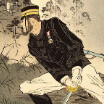


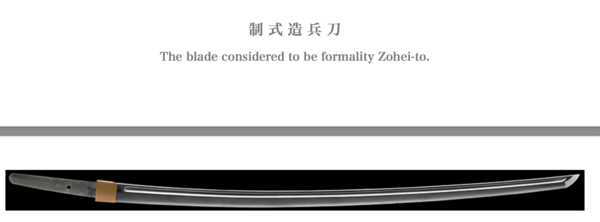









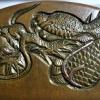






(1).thumb.jpg.4d8b4e979dd2c0a3ad9c597311b3e0aa.jpg)


